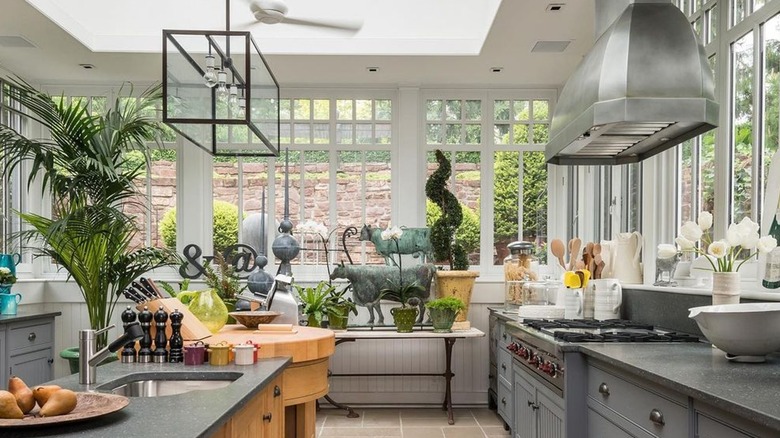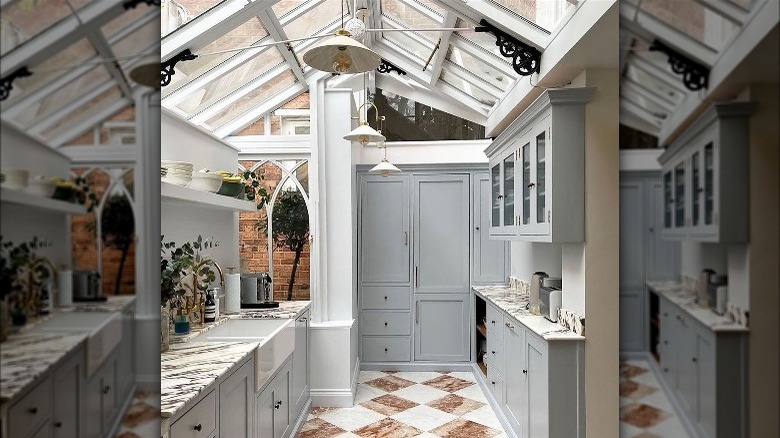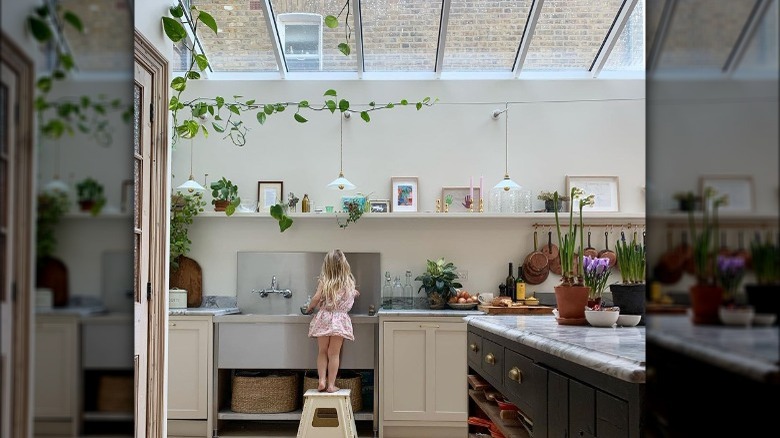What To Know About Greenhouse Kitchens Before Building One
If you frequently dream of cooking in the open summer air or brewing tea by a rainy winter window, a greenhouse kitchen may become your new obsession. Where some fully functioning kitchens are sheltered inside a conservatory, orangery or sunroom, a greenhouse kitchen brings the conservatory to the kitchen. A greenhouse kitchen can serve as the primary cooking and dining area or simply function as a secondary kitchen, ideal for use when the weather suits you. Of course, being so exposed to the elements brings some unique challenges. Greenhouse kitchens are prone to strong temperature fluctuations and leaky or broken windows, and they can be quite pricey to build and maintain.
With the rising love of cottagecore, vintage accents, and biophilic interior decor, perhaps it comes as no surprise that we'd all "ooo" and "ahh" over the idea of a greenhouse kitchen. But it's important to look realistically at the risks and benefits before building one. Learn more about what you need to consider before breaking ground on your greenhouse kitchen and how you should design your project to perfectly blur the line between home and nature.
Plan your dream kitchen with caution
If you're building a greenhouse kitchen from the ground up, you're essentially building a conservatory or sunroom from scratch with the added complication of plumbing and appliances. Before launching into a building project, it's crucial to consider the pros and cons of these "in-between" spaces and how they might affect your kitchen's daily usability. Because they are surrounded by glass and often detached from central air, greenhouse kitchens will be very cold in the winter and hot in the summer. Maintaining a stable temperature could quickly rack up your electric bill, but allowing the kitchen to freeze can lead to even more costly plumbing repairs.
Of course, a greenhouse kitchen has some advantages over an ordinary outdoor kitchen. For one, it is sheltered, so there's more you can do to control how the elements affect your space. Always arrange plumbing so it lies within an inner, insulated wall, and never an outer wall that's subject to freezing temperatures. You may also want to consider laying in-floor heating elements to make the kitchen more comfortable in winter and further reduce the risk of frozen pipes. Choose windows with a good energy efficiency rating, and ensure that you can open a few to release humidity and let a cool breeze flow through in the summer. Sun shades and a small woodstove or fireplace can also be charming additions to help you balance the temperature.
Embrace beauty in biophilic details
After you've planned how to safely and efficiently build your greenhouse kitchen, you can start playing with additional details. A greenhouse kitchen is all about blurring the lines between the home and nature and gaining a deeper understanding of where our food comes from. In addition to being a beautiful and enjoyable structure, a greenhouse kitchen can be an ideal arrangement for people seeking to live off-grid, garden more, or develop a homesteading lifestyle. Ample sunlight makes the greenhouse kitchen a perfect place to sprout seeds, grow herbs, and protect your plants from frost and harsh weather. Growing produce indoors can also extend your growing season and put more fresh food on the table. To take full advantage of your greenhouse kitchen, design and build your structure with space intended for growing food.
If you're not in the market to build a brand new greenhouse kitchen yet, there are more affordable and reliable ways to embrace the trend. Add live plants wherever possible in your kitchen and dining space, especially herb plants like dill, basil, and mint. Keep windows open, bright, and free from fussy window treatments to allow as much light into the space as possible. Finally, consider smaller renovation projects that will make your space feel more distinct, such as adding a skylight.


